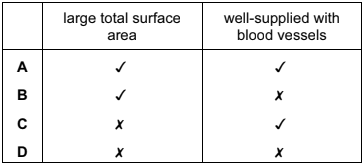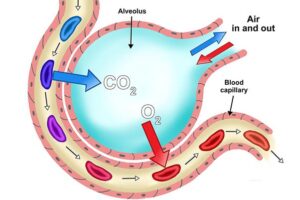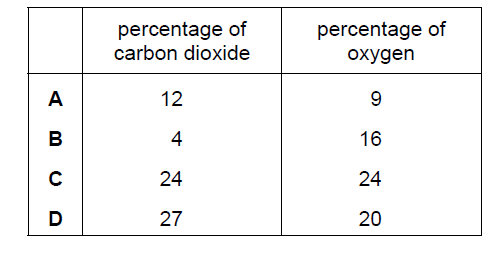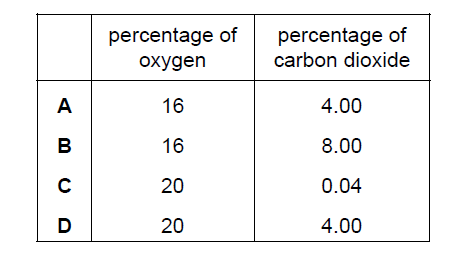Question
What is the approximate percentage of oxygen in expired air?
A 0.04% B 4% C 16% D 21%<
▶️Answer/Explanation
C
The approximate percentage of oxygen in expired air is c, 16%. When we breathe in, the air contains approximately 21% oxygen, which is then used by our body for various metabolic processes. When we exhale or expire, the air that leaves our lungs it contains about 16% oxygen, while the remaining percentage is mainly nitrogen, along with small amounts of other gases like carbon dioxide and water vapor.
Question
What makes alveoli suitable as a gas exchange surface?

 Answer/Explanation
Answer/Explanation
A
Alveoli are small, thin-walled sacs located at the end of the bronchioles in the lungs. They are the primary sites of gas exchange in the respiratory system, responsible for the exchange of oxygen and carbon dioxide between the air in the lungs and the bloodstream. Several factors make alveoli highly suitable as a gas exchange surface:
1. Large total Surface Area: The alveoli provide an enormous surface area for gas exchange. The human lungs contain approximately 300 million alveoli, which collectively offer a surface area of around 70 square meters (about the size of a tennis court). This extensive surface area allows for a large volume of gases to diffuse across the alveolar membrane efficiently.
2. Well-supplied with Blood vessels: The alveoli are surrounded by an extensive network of tiny blood vessels called pulmonary capillaries. This network ensures a constant and high flow of blood near the alveoli, maintaining a steep concentration gradient for oxygen and carbon dioxide between the air and the blood. This concentration gradient promotes efficient gas exchange.
Overall, the combination of a large surface area, thin membrane, moist environment, good blood supply, and proper ventilation-perfusion matching makes alveoli highly efficient gas exchange surfaces, ensuring a continuous supply of oxygen to the body and the removal of carbon dioxide waste.

Question
Which row shows the approximate percentage of gases in expired air?

▶️Answer/Explanation
B
The approximate percentage of oxygen (O2) and carbon dioxide (CO2) gases in expired air can vary depending on several factors, including the individual’s metabolism, activity level, and overall health. However, the following values are commonly referenced:
1. Oxygen (O2): The percentage of oxygen in expired air is generally around 16%. This is lower than the concentration of oxygen in ambient air, which is around 21%. The decrease in oxygen percentage occurs because the body utilizes oxygen for metabolic processes, and the remaining oxygen is exhaled.
2. Carbon Dioxide (CO2): The percentage of carbon dioxide in expired air is typically around 4%. This concentration is significantly higher than the concentration of CO2 in ambient air, which is approximately 0.04%. The increase in CO2 percentage is due to the body’s production of carbon dioxide as a byproduct of cellular respiration, which is then exhaled.
It’s important to note that these values are approximate and can vary depending on the individual’s physiological state and the respiratory exchange occurring in the lungs.
Question
What are the approximate percentages of oxygen and carbon dioxide in inspired air?

▶️Answer/Explanation
C
The approximate percentage of oxygen (O2) and carbon dioxide (CO2) gases in inspired air can vary slightly depending on various factors such as altitude, pollution levels, and breathing patterns. However, under normal conditions, the approximate percentages are as follows:
1. Oxygen (O2): The percentage of oxygen in inspired air is about 20.95%. This level of oxygen is relatively constant in the Earth’s atmosphere and is considered the normal concentration in ambient air.
2. Carbon Dioxide (CO2): The percentage of carbon dioxide in inspired air is relatively low, typically around 0.04%. This is equivalent to 400 parts per million (ppm).
It’s important to note that these percentages represent the composition of gases in the Earth’s atmosphere at sea level. At higher altitudes, the percentage of oxygen remains relatively constant, but the overall air pressure decreases, resulting in lower oxygen partial pressure.
Question
The diagram shows an amoeba, a single-celled living organism.

The movement of gases at X indicates the occurrence of which process or processes in the cell?
A excretion and nutrition
B excretion and respiration
C nutrition and respiration
D respiration only
▶️Answer/Explanation
B
In amoebas, X indicates the occurrence the movement of gases is related to the processes of excretion and respiration.
1. Respiration: Amoebas, like all living cells, require energy to carry out their functions. They obtain this energy through a process called cellular respiration. During cellular respiration, they break down organic molecules, such as glucose, in the presence of oxygen (aerobic respiration) or without oxygen (anaerobic respiration). This process releases energy, carbon dioxide (CO2), and water (H2O). The movement of gases, particularly the intake of oxygen and the release of carbon dioxide, helps the amoeba in obtaining the necessary oxygen for respiration and expelling the waste product, carbon dioxide.
2. Excretion: As part of their normal metabolic activities, amoebas also produce waste products that need to be eliminated to maintain cellular health. The movement of gases, especially the expulsion of carbon dioxide, plays a role in the excretion process. Carbon dioxide is a waste product of cellular respiration, and its accumulation can be harmful to the amoeba. By moving gases in and out of the cell, the amoeba ensures that waste products are eliminated, helping to maintain a proper internal environment.
In amoebas, gas exchange occurs through simple diffusion. The cell membrane is permeable to gases like oxygen and carbon dioxide, allowing them to move freely in and out of the cell as needed for respiration and excretion. This process enables amoebas to maintain a balance of gases within their cells and ensure their survival.
